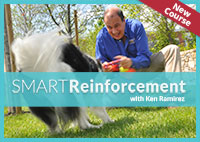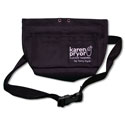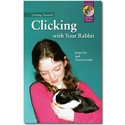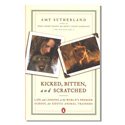Why train your critter?
Ferrets, hamsters, mice, rats, sugar gliders, flying squirrels, guinea pigs, rabbits, chinchillas, and other small pets.
They are all furry and lovable, of course, quirky and silly, sometimes, full of energy and mischief, undoubtedly—but trainable?

You bet! Clicker training is a way to communicate with and get insight into any pet. Training is fun for you and the pet, and helps to develop a bond between human and animal. When you train your pet, you are allowing that pet to use its natural abilities, and offering mental and physical stimulation. A trained pet will delight you with tricks and antics—you’ll want to take your pet out of the cage more often to play!
Clicker training is the tool for you if you would like to engage in more activities with your pet, improve aspects of your pet’s behavior, clip your pet’s nails without a fight, teach your pet to come out from behind the fridge, or simply enhance your relationship with your pet.
Training all kinds
We have yet to encounter a pet that cannot be clicker trained. Some pets learn more quickly, some will work longer, and some get overwhelmed easily, but you can clicker train any pet that can be motivated by something that you have and it wants. Sometimes it takes a pet a few training sessions to get used to the sound of the clicker or to associate the click with the treat, but some pets catch on right away. Some pets are so thrilled with clicker training that they tell all their friends!
We taught Gwen the ferret to touch a ball with her nose. In her zeal, she actually leapt onto the ball from the back of the couch. When she realized that she was controlling the game, she became so excited by the click that she did a happy ferret dance without even receiving her treat. The next day, Gwen taught eight other ferrets to touch the ball to get a click and treat! This type of mimicking in animals is not uncommon. Marigold the guinea pig was watching a rabbit learning to touch a target. She went over to the trainer and touched the target 10 times in a row for a click and a treat—without any previous training.
Tips for Success
- Be sure your pet is healthy and receiving adequate nutrition and has free access to fresh water at all times.
- Use good treats—the reward must be more interesting to the pet than distractions in the environment.
- Be patient. Allow the pet ample time and opportunity to explore the training area (this may take more than one session).
- Provide the pet with a comfort zone such as a non-slip mat and litter box, or even a covered box to hide in if necessary.
- Click and treat in the cage at first if the pet is nervous on the outside.
- Work in a low distraction environment at first. Use barriers and remove anything that you do not want the pet to investigate.
- Keep sessions short—2 minutes is plenty at first.
- Some pets are easily overwhelmed. Repeat one step only a few times per session.
- Use several different types of treats in each session and reserve special treats for training only.
- During training, never say no, scold, use physical force, or do anything the pet might find aversive
The key to success with clicker training a small pet is understanding the pet. Observe what it likes to eat, what behaviors it does naturally, and what environment it prefers. Consult resources online or visit the library to find out what others have observed about your type of pet. You need to know what type of home and what toys and activities it likes, how to keep it healthy, and what treats you can use for training.
Getting started: finding the right reinforcers
To begin, all you need is a clicker (or anything that makes a consistent sharp sound) and something that your pet wants that you can readily provide. Possible reinforcers are food, praise, attention, petting, toys, and games. To identify the best reinforcer for your pet, observe what makes it happy. Remember, if the pet tries to hide or run from you, then your actions are not making it happy!
Food is the easiest treat to deliver and is the most powerful reward for most pets. It’s also the best reinforcer to use when teaching new lessons, so I recommend that you start your training with a food reinforcer. Introduce other types of reinforcers once the pet is very interested in clicker training. (Do not abandon food altogether, though. It is important to maintain a strong positive association with the click sound, and using food as the reinforcer is usually the best way to do that.)
To identify favorite food treats, offer a mixture in a bowl and see which treat your pet chooses first. Once you identify favorite foods, reserve them for training. To avoid feeding your pet too many treats, measure out the treats for the day. When they are used up, the training is over.
Some pets may work for part of their regular food ration. Do not withhold food from your pet to make it hungry for training. This is not consistent with the positive nature of clicker training, and animals that are frantic for food are not in a good state of mind for stress-free learning. Take the food bowl out of the cage an hour or so before a training session, especially with very small pets, to be sure the pet is not stuffed full before a training session, but do not starve the pet to increase motivation for food.
Observe your pet to see when it likes to eat and do your initial training sessions at that time. If you have a pet such as a rat, mouse, or hamster that stores food in a pantry, use as much as you like of a favorite food during a training session and then take most of it back when the pet is not looking. It’s a good thing small pets can’t count!
If you opt to use handling as a reinforcer, pay close attention to what pleases your pet. You may think that your pet enjoys certain types of handling, but it may be saying otherwise with body language. Observe your pet. If you see lip licking, yawning, scratching, or sneezing when you try to interact with your pet, the pet is telling you that it is feeling anxious. If your pet shakes (like a wet dog) or frantically grooms when you stop touching, then the pet did not like the touching.
Many animals become very intense when involved in clicker training. While they may ordinarily enjoy petting or handling, they may not want this kind of handling when they are trying to learn.
Regardless of the reinforcer you choose, don’t be surprised if something the pet likes one day is of no interest the next, or if your pet suddenly wanders off in the middle of a training session. This happens in training with many animals, so just be patient and have fun with your pet. Clicker training is about building a relationship and forming a bond of trust with your animal. If the pet is not in the mood for training, then just wait and try another time. Try to train in very short sessions (1-2 minutes) and stop after success and while both you and the pet still want more.
Timing the click
The first goal is to create an association between the click and the treat. The click must come immediately before the treat to build that association. Put a piece of food on the ground or in a dish. As soon as the pet has its mouth nearly on the food, click. Wait for the pet to do something: take a step, look at you, move a paw. After any movement, click and treat. That’s the second step—clicking for any movement at all. At this point, what you want is for the pet to get used to the sound of the click and to start making a positive association with the click.
When you move to the next step, clicking for a movement that you want repeated, the click must occur at the exact moment the pet performs the movement. Choose a movement that is very easy and that the pet is likely to repeat so that you can give lots of clicks and treats. Your pet will soon try to repeat behaviors that earned a click and a treat. One, two, three—the game is on!
In some of the older literature about clicker training we used to recommend “charging the clicker.” That meant clicking/treating for no reason in order to build the association between click and treat. Today, leading clicker trainers don’t believe charging the clicker is necessary. In fact, it can actually be detrimental to training. Once we trained a guinea pig to stay perfectly still. She was so convinced that lack of movement was the key to success that she would not move for anything! Now we build the click/treat association while also looking for some action by the animal.
The training area
Give your pet lots of opportunity to explore the training area while you supervise. For very small pets such as mice and hamsters, the training area can be a box with high sides. The bathtub can be a good training area for rats and smaller pets. Be sure to line it with a non-slip rubber pad and close the drain hole. The bathroom is a good training area for rabbits, degus, chinchillas, ferrets, sugar gliders, and flying squirrels. The bathroom can usually be stripped of most distractions and can provide a safe area where the pet can explore without finding too much excitement. Make sure the toilet lid is closed and secured, and place a towel at the bottom of the door in the case of sugar gliders and flying squirrels.
If you and your clicker and treats are the most interesting things in the room, you will soon find that your pet spends more time interacting with you. (Encourage flying squirrels and sugar gliders to enjoy your company by carrying them around in your pocket or in a special sleeping bag during the day while they are sleeping. This helps them bond with you and want to be near you when they are awake.)
As you spend time with your pet in the training area, remember to click and treat for any interaction that you want to encourage. When your pet has learned to come to you and do some tricks in the bathroom or other restricted training area, move on to training in other areas where there may be more distractions. Be sure to give your pet lots of time to explore a new area and don’t expect the same level of response at first. A puppy-exercise pen is a good way to restrict your pet while training in various locations.
Note that the training area should always have a litter box for pets that use one and a box or house where a pet can hide if it feels insecure.

What can I teach my pet?
With clicker training you can teach your pet to do anything it is physically capable of doing. Start with behaviors that your pet does naturally. For example, all pets move around and can be taught to come when called, a behavior that is useful as well as impressive. At first, your pet will have no idea what you are doing when you start to train “come” and may take a few sessions to catch on. Be patient—even fish can learn to do behaviors on cue!
Teaching the cue "come"
Click and treat if your pet looks at you or in your general direction. Click and treat if the pet takes a step toward you. You can do this while the pet is in the cage, or out of the cage in your training area. Click and treat every time the pet comes into your space. When the pet seems to come toward you intentionally, start to move around a little so that the pet has to work a little harder to get the click and treat.
When you are sure that your pet is coming toward you on purpose, add the cue “come” (plus your pet’s name if you wish). Add the cue only after the animal knows how to perform the behavior and does it on its own. Click when the pet gets partway to you and give the treat when your pet arrives, or even toss the treat for your pet to pick up off the floor.
Give the cue “come” only when you know that the pet is already on the way. This ensures that the cue “come” is only ever associated with the action of coming. If your pet is going in the opposite direction, or sitting still, and you say “come” repeatedly, it teaches the pet that “come” means run away or sit still.
Once you have said the word “come” while the pet is already coming to you and given a click and treat for this 50 times (over several short training sessions), try saying the word before the pet starts to come to see if your pet understands the cue. If your pet comes, practice calling the pet from very close by and, eventually, further and further away. Add increasing levels of distraction, with a click and treat for every correct response.
If the pet does not come, practice some more saying the cue “come” while the pet is already coming to you—until the pet associates the cue “come” with the action of coming to you.
After many repetitions, reduce the frequency of the click/treat when the pet comes on cue. Instead, reward your pet with a game or a new toy or something else the pet likes. Never call the pet and then do something unpleasant. If you must capture the pet to put it away or do a veterinary procedure, get to it some other way. Never use the cue “come” in this situation.
The first cue is the most difficult to teach. Once the pet gets the idea that the cues you give are opportunities for it to do an action and receive a click and treat, it will be easier to teach more cues for other behaviors. The sequence in teaching cues is always the same:
- Get the behavior happening on its own (click/treat every time the pet does the behavior)
- Say the cue word (or give the hand signal cue) at the same time the pet is doing the behavior (click/treat every time)
- Finally, give the cue before the behavior, and click/treat when the pet responds correctly

Target training
Pets can also be taught to touch a target with a nose or paws. Target training is useful for teaching new behaviors, and for leading your pet around without a leash. A suitable target can be a small ball on the end of a stick, a margarine container lid, or anything that you can hold and the pet can see easily. Pets can be taught to touch a target through shaping, the process where a behavior is developed incrementally. Shape behaviors by raising the criteria required for the pet to receive a click. In other words, ask your pet to work a little harder for the click.
To teach a pet to follow a target (a ball), place the ball on the ground; click and treat if the pet looks at the ball. Then click/treat when the pet takes a step toward the ball, and then when it actually touches the ball. Next hold the ball in your hand and click/treat for looking at the ball, then touching it, and so on until the pet moves to touch the ball wherever you hold it.
Use the ball to move the pet from place to place. Attach the ball to the end of a stick and guide the pet. Click/treat after one step of following the ball, then two steps and so on until the pet will follow the ball wherever you move it.
In shaping, as in all aspects of clicker training, ignore mistakes. If your pet does not receive a click three times in a row, lower the criteria temporarily (go back to a step that your pet performed reliably to earn a click) to ensure success and to prevent frustration. A frustrated pet may refuse to play anymore, and may leave you to conduct more important small-pet business.
Useful behaviors
In addition to coming when called, as described above, other useful behaviors include walking beside you, going into the cage, going into the litter box, learning to trust, following a new person, going to bed on cue, sitting on your shoulder, in your hands, or in a basket, and being gentle with mouths during human interactions. Use targeting to train these useful behaviors; the target guides the pet as you demonstrate what you expect. Once the new behavior is happening reliably, reduce the use of the target by making it disappear before the pet actually touches it, all the while clicking and treating for the behavior or the position you are trying to teach.
Use the general shaping approach to teach each new trick. Use the target, or set up the training area in such a way that the pet is almost certain to do the behavior you want. Click and treat for anything the pet does that is getting closer to the desired behavior. This is like the child’s game of “hot and cold.” The click and treat is the “hot” and the absence of the click and treat translates to “cold.” Remember that your pet will not learn any faster if you say “no” or otherwise indicate it is wrong. In fact, you pet may just quit playing the game altogether.

Fun behaviors
You are limited only by your imagination and the physical abilities of your pet in terms of the tricks that you can train. Your pet can go under, over, or through obstacles. Many pets can jump, run, and climb. Some pets can grasp and hold objects with their paws. Sugar gliders can grasp with their tails, gerbils can wink, flying squirrels can leap from shoulder to shoulder, and guinea pigs can sing. You can turn these behaviors into tricks by shaping (or by “capturing” them with a click when they happen naturally) and then putting them on a verbal cue or hand signal.
Remove the clicker and treats, but a clicker pet is forever
You do not need to click/treat forever. Once a behavior is learned and a cue is established, the click/treat can be removed by using it less frequently, and then only occasionally. There is no rush to eliminate the click/treat, though. The longer a behavior has been reinforced, the stronger it will be and the less likely it will be to weaken and disappear. If some day a pet seems to have forgotten everything it ever learned, just go back to the beginning and start again. Suddenly, everything will come back, more quickly than the first time.
Once your pet starts offering behaviors intentionally, and looking at you as if to say “Is this it? How about this?” it will be clear that you have a clicker pet. Move on to teaching more advanced skills and chaining behaviors together.
For more information about clicker training with small critters, consult other articles on this topic in the clicker training library. The clicker training store has books and DVDs that can help you expand your training, too. Finally, you may want to join the clicker bunny and critter Yahoo group, a discussion group dedicated to small pet training.








Post new comment